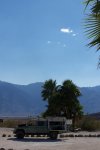teotwaki
Excelsior!
Of that 274 M visits, only 61M are in NParks (as opposed to parkways, memorials, rec areas, etc)
How would these figures change if the park service changed the backcountry access rules? For one thing, how much backcountry area is closed to wheeled transport purely on administrative grounds, as opposed to area which does not have any roads?
Looking at the 2007 visitor statistics I see that the top ranked parks are:
Blue Ridge PKWY (6%) - that is a road, no backcountry
Golden Gate NRA (5%) - that is an urban rec area. Are bikes allowed there?
Great Smoky Mtns (3%) - an old park
...
Lake Mead NRA (3%) - again a rec area; access rules are much looser
...
Grand Canyon NP (1.6%) - are there good backcountry camping areas with closed roads?
...
Yosemite NP (1.3%) - again, an old park; have any roads been closed? Most visitors never leave the Valley
...
Yellowstone NP (1.1%) - most visitors drive the paved loops, stopping to look at the verious geysers and animals. Winter access via snowmobile has been a major bone of contention. But aren't most of the snow mobile trips, day trips out of W Yellowstone?
Olympic NP (1%) - again an old one; there are a limited number of access roads; none go through the park; I'm not aware of any being closed in the last couple of decades.
Rocky Mtn NP - again an old established one; most visitors stick to the paved ridge road, and day trips out of Estes.
Zion, Gand Teton, Acadia, Glacier - none of these have been known for 4x4 or backcountry driving
Joshua Tree, ranked 56th, is the first that I seen in the list where park growth may have restricted backcountry driving.
Death Valley, rank 90, 0.26%, 700,000 visitors. Allowing more backcountry driving here would not change the statistics very much.
Backcountry camping has had its ups and downs. At a peak around 1980, a low around 1990, back up in the late 1990s, lower now (though not as low as 1990). I doubt if those numbers can be tied to changes in wilderness designation.
Okay but we need the rest of the story if we are to dissect the numbers in detail. If we knock the 274 M down by 75% to 61 M and just leave the backcountry visits to 1.8 M that is still less than 3% of the visits attributable to a group of people in the minority. I suspect that the 1.8M has to go down a lot too. So do we leave it at 3% or go for less? Tail wagging the dog? Still a tiny-tiny group of folks getting special priviledge. (I am one of them as I go to wilderness areas.)
As before, I did not say that we should remove what wilderness we have, bulldoze new roads or whatever other falsehoods have been attributed to me. I say stop closing any more roads until there is some sort of plan, even to collect fees to help with the maintenance. Some try to deflect things with arguments that the roads were probably closed due to staffing shortages, funding shortages, etc. Fine, don't keep expanding wilderness that requires more staff and more management and requires funding that cannot be found for current parks and their already existing roads.
I understand that the camping numbers go up and down but if all of the same reports as I quoted were pulled I doubt we would see any shocking increase of the tiny-tiny percent of wilderness backpackers over the years. They're likely to remain a minority forever. Yes, I know wilderness is needed to be just that and doesn't need human backpackers roaming about, but it is also true that not all existing roads need to be closed just because we sneak in a bill that declares more wilderness in lands already under Federal control.
Last edited:

